Community-Level Analysis of Drinking Water Data Highlights the Importance of Drinking Water Metrics for the State, Federal Environmental Health Justice Priorities in the United States
Abstract
:1. Introduction
2. Materials and Methods
3. Results
3.1. Combined Data Set for Drinking Water Contaminant Occurrence for the U.S.
3.2. Attribution of Demographic Data to Community Water Systems
3.3. Analysis of Cumulative Cancer Risk and Demographic Data for Community Water Systems
4. Discussion
5. Conclusions
Author Contributions
Funding
Institutional Review Board Statement
Informed Consent Statement
Data Availability Statement
Acknowledgments
Conflicts of Interest
Appendix A
| Contaminant | Maximum Contaminant Level (MCL) Set by the U.S. EPA | One-in-a-Million Cancer Risk Level | Reference for the Cancer Risk Level |
|---|---|---|---|
| Group of 5 haloacetic acids (HAA5) | 60 μg/L | 0.1 μg/L | [15] |
| Group of 9 haloacetic acids (HAA9) | Not available | 0.06 μg/L | [15] |
| Group of 4 trihalomethanes (THM4) | 80 μg/L | 0.15 μg/L | [13] |
| Nitrate (as nitrogen) | 10 mg/L | 0.14 mg/L | [28] |
| 1,4-Dioxane | Not available | 0.35 μg/L | [30] |
| 1,2,3-Trichloropropane | Not available | 0.0007 μg/L | [31] |
| 1,2-Dibromo-3-chloropropane | 0.2 μg/L | 0.0017 μg/L | |
| Arsenic | 10 μg/L | 0.004 μg/L | |
| Benzene | 5 μg/L | 0.15 μg/L | |
| Bromate | 10 μg/L | 0.1 μg/L | |
| Carbon tetrachloride | 5 μg/L | 0.1 μg/L | |
| Hexavalent chromium | Not available | 0.02 μg/L | |
| Radium-226 &-228 | 5 pCi/L | 0.05 pCi/L | |
| Strontium-90 | Not available | 0.35 pCi/L | |
| Tetrachloroethylene | 5 μg/L | 0.06 μg/L | |
| Trichloroethylene | 5 μg/L | 0.4 μg/L | |
| Tritium | Not available | 400 pCi/L | |
| Uranium, combined | 30 μg/L | 0.43 pCi/L | |
| Vinyl chloride | 2 μg/L | 0.05 μg/L |
| Data Analysis | Demographic Group | Tercile 1 | Tercile 2 | Tercile 3 |
|---|---|---|---|---|
| California, all systems serving populations ≥501 people | Percent of population Black or African American | ≤0.9% Total population in the tercile: 2.6 million | 0.9–2.9% Total population in the tercile: 11.3 million | ≥2.9% Total population in the tercile: 21.3 million |
| Percent of population Hispanic or Latino | ≤17.9% Total population in the tercile: 5.8 million | 18.1–39.9% Total population in the tercile: 13.3 million | ≥40.5% Total population in the tercile: 16.1 million | |
| Texas, all systems serving populations ≥501 people | Percent of population Black or African American | ≤3.2% Total population in the tercile: 4.3 million | 3.2–10.9% Total population in the tercile: 10.7 million | ≥10.9% Total population in the tercile: 11.5 million |
| Percent of population Hispanic or Latino | ≤15.4% Total population in the tercile: 3.5 million | 15.4–29.4% Total population in the tercile: 5.9 million | ≥29.4% Total population in the tercile: 17.0 million |
References
- Hajat, A.; Hsia, C.; O’Neill, M.S. Socioeconomic Disparities and Air Pollution Exposure: A Global Review. Curr. Environ. Health Rep. 2015, 2, 440–450. [Google Scholar] [CrossRef] [PubMed] [Green Version]
- Tessum, C.W.; Apte, J.S.; Goodkind, A.L.; Muller, N.Z.; Mullins, K.A.; Paolella, D.A.; Polasky, S.; Springer, N.P.; Thakrar, S.K.; Marshall, J.D.; et al. Inequity in consumption of goods and services adds to racial-ethnic disparities in air pollution exposure. Proc. Natl. Acad. Sci. USA 2019, 116, 6001–6006. [Google Scholar] [CrossRef] [PubMed] [Green Version]
- Alvarez, C.H.; Evans, C.R. Intersectional environmental justice and population health inequalities: A novel approach. Soc. Sci. Med. 2021, 269, 113559. [Google Scholar] [CrossRef] [PubMed]
- Ekenga, C.C.; Yeung, C.Y.; Oka, M. Cancer risk from air toxics in relation to neighborhood isolation and sociodemographic characteristics: A spatial analysis of the St. Louis metropolitan area, USA. Environ. Res. 2019, 179, 108844. [Google Scholar] [CrossRef] [PubMed]
- McDonald, Y.J.; Jones, N.E. Drinking water violations and environmental justice in the United States, 2011–2015. Am. J. Public Health 2018, 108, 1401–1407. [Google Scholar] [CrossRef] [PubMed]
- Switzer, D.; Teodoro, M.P. The color of drinking water: Class, race, ethnicity, and safe drinking water act compliance. J. Am. Water Works Assoc. 2017, 109, 40–45. [Google Scholar] [CrossRef] [Green Version]
- Fedinick, K.P.; Taylor, S.; Roberts, M. Watered Down Justice. 2020. Available online: https://www.nrdc.org/resources/watered-down-justice (accessed on 11 August 2021).
- Josset, L.; Allaire, M.; Hayek, C.; Rising, J.; Thomas, C.; Lall, U. The US Water Data Gap—A Survey of State-Level Water Data Platforms to Inform the Development of a National Water Portal. Earth’s Futur. 2019, 7, 433–449. [Google Scholar] [CrossRef] [Green Version]
- Bangia, K.; August, L.; Slocombe, A.; Faust, J. Assessment of contaminants in California drinking water by region and system size. AWWA Water Sci. 2020, 2, e1194. [Google Scholar] [CrossRef]
- California Office of Environmental Health Hazard Assessment. Draft CalEnviroScreen 4.0. 2021. Available online: https://oehha.ca.gov/calenviroscreen/report/draft-calenviroscreen-40 (accessed on 15 July 2021).
- National Academies of Sciences, Engineering and Medicine. Quality Water from Every Tap: Proceedings of a Workshop—in Brief; The National Academies Press: Washington, DC, USA, 2021. [Google Scholar]
- Stoiber, T.; Temkin, A.; Andrews, D.; Campbell, C.; Naidenko, O.V. Applying a cumulative risk framework to drinking water assessment: A commentary. Environ. Health 2019, 18, 1–8. [Google Scholar] [CrossRef] [PubMed] [Green Version]
- Evans, S.; Campbell, C.; Naidenko, O.V. Cumulative risk analysis of carcinogenic contaminants in United States drinking water. Heliyon 2019, 5, e02314. [Google Scholar] [CrossRef] [PubMed] [Green Version]
- United States Environmental Protection Agency. Monitoring the Occurrence of Unregulated Drinking Water Contaminants. Available online: https://www.epa.gov/dwucmr (accessed on 12 July 2021).
- Evans, S.; Campbell, C.; Naidenko, O.V. Analysis of Cumulative Cancer Risk Associated with Disinfection Byproducts in United States Drinking Water. Int. J. Environ. Res. Public Health 2020, 17, 2149. [Google Scholar] [CrossRef] [PubMed] [Green Version]
- Andrews, D.Q.; Naidenko, O.V. Population-Wide Exposure to Per-and Polyfluoroalkyl Substances from Drinking Water in the United States. Environ. Sci. Technol. Lett. 2020, 7, 931–936. [Google Scholar] [CrossRef]
- Fedinick, K.P.; Wu, M. Threats on Tap: Widespread Violations Highlight Need for Investment in Water Infrastructure and Protections. 2017. Available online: https://www.nrdc.org/resources/threats-tap-widespread-violations-water-infrastructure (accessed on 23 August 2021).
- United States Environmental Protection Agency. Technical Support Document, EPA’s 2014 National Air Toxics Assessment. 2018. Available online: https://www.epa.gov/sites/default/files/2018-09/documents/2014_nata_technical_support_document.pdf (accessed on 15 July 2021).
- United States Census Bureau. 2020. Available online: https://www.census.gov/topics/population/race/about.html (accessed on 15 July 2021).
- United States Environmental Protection Agency. EJSCREEN: Environmental Justice Screening and Mapping Tool. Available online: https://www.epa.gov/ejscreen (accessed on 15 June 2021).
- Balazs, C.L.; Morello-Frosch, R.; Hubbard, A.E.; Ray, I. Environmental justice implications of arsenic contamination in California’s San Joaquin Valley: A cross-sectional, cluster-design examining exposure and compliance in community drinking water systems. Environ. Health 2012, 11, 84. [Google Scholar] [CrossRef] [PubMed] [Green Version]
- Schaider, L.A.; Swetschinski, L.; Campbell, C.; Rudel, R.A. Environmental justice and drinking water quality: Are there socioeconomic disparities in nitrate levels in US drinking water? Environ. Health 2019, 18, 1–15. [Google Scholar] [CrossRef] [PubMed] [Green Version]
- Gehlert, S.; Hudson, D.; Sacks, T. A Critical Theoretical Approach to Cancer Disparities: Breast Cancer and the Social Determinants of Health. Front. Public Health 2021, 9, 674736. [Google Scholar] [CrossRef] [PubMed]
- LaVeist, T.A. Minority Populations and Health: An Introduction to Health Disparities in the United States; John Wiley & Sons: Hoboken, NJ, USA, 2005; Volume 4. [Google Scholar]
- National Cancer Institute Surveillance, Epidemiology and End Results Program. Cancer Stat Facts: Cancer Disparities. Available online: https://seer.cancer.gov/statfacts/html/disparities.html (accessed on 10 September 2021).
- U.S. Government Accountability Office. Drinking Water: EPA Could Use Available Data to Better Identify Neighborhoods at Risk of Lead Exposure; U.S. Government Accountability Office: Washington, DC, USA, 2020.
- United States Environmental Protection Agency. Environmental Quality Index (EQI). 2020. Available online: https://www.epa.gov/healthresearch/environmental-quality-index-eqi (accessed on 20 August 2021).
- Temkin, A.; Evans, S.; Manidis, T.; Campbell, C.; Naidenko, O.V. Exposure-based assessment and economic valuation of adverse birth outcomes and cancer risk due to nitrate in United States drinking water. Environ. Res. 2019, 176, 108442. [Google Scholar] [CrossRef] [PubMed]
- California Office of Environmental Health Hazard Assessment. Perfluorooctanoic Acid (PFOA) and Perfluorooctane Sulfonate (PFOS) in Drinking Water. 2021. Available online: https://oehha.ca.gov/water/report/perfluorooctanoic-acid-pfoa-and-perfluorooctane-sulfonate-pfos-drinking-water (accessed on 20 August 2021).
- United States Environmental Protection Agency. 1,4-Dioxane. Available online: https://iris.epa.gov/ChemicalLanding/&substance_nmbr=326 (accessed on 30 June 2021).
- California Office of Environmental Health Hazard Assessment. Public Health Goals. Available online: https://oehha.ca.gov/water/public-health-goals-phgs (accessed on 30 June 2021).
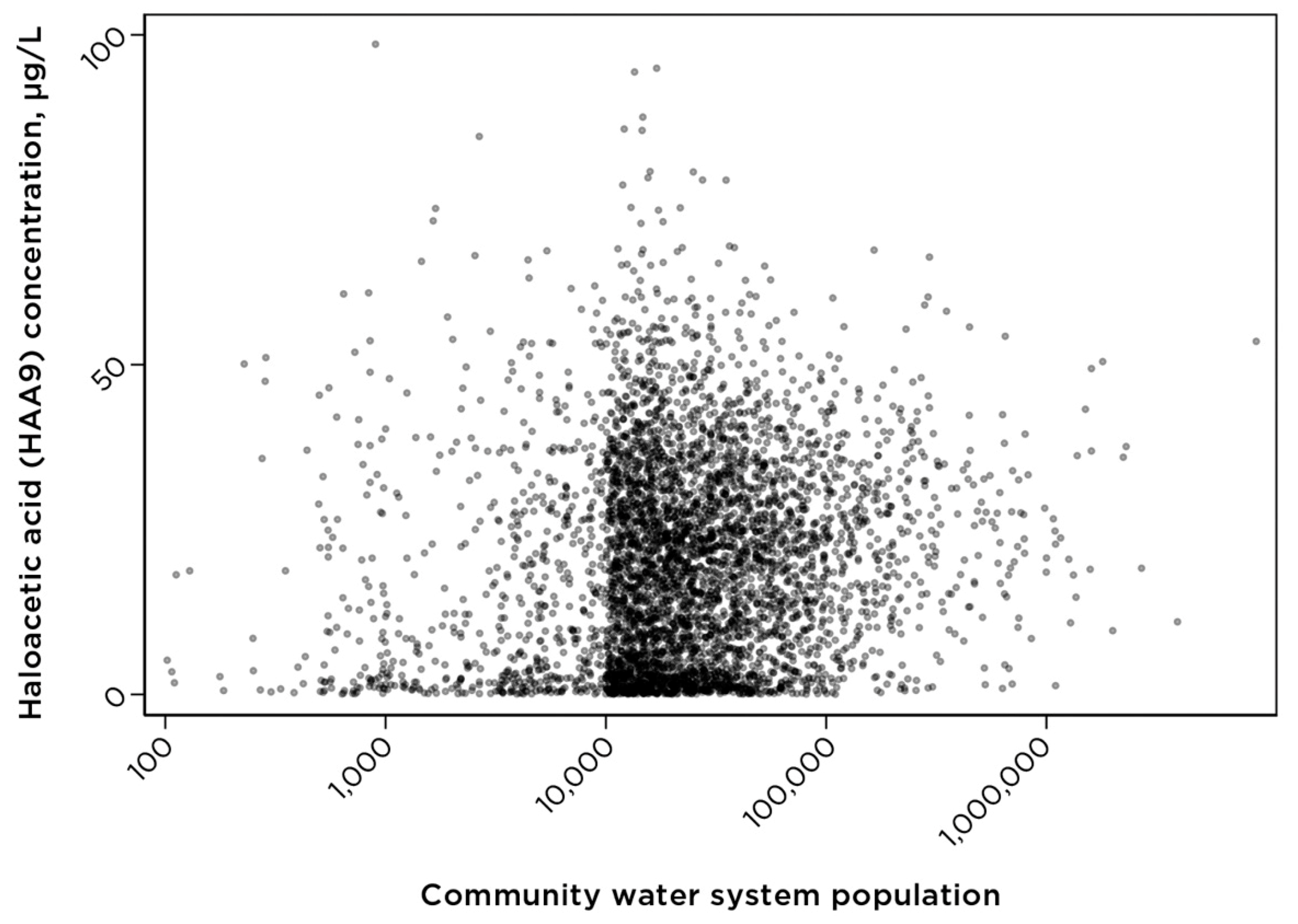
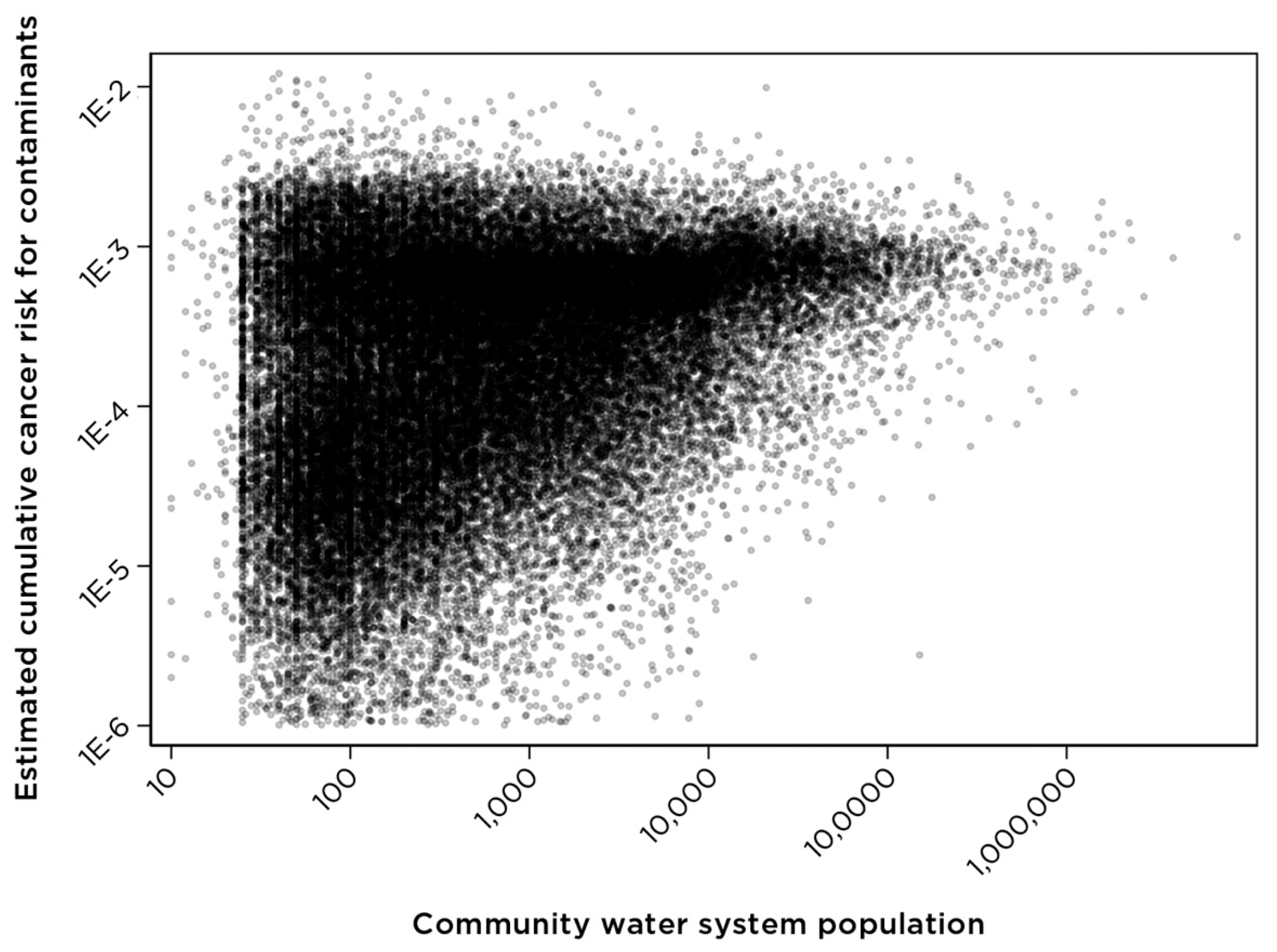
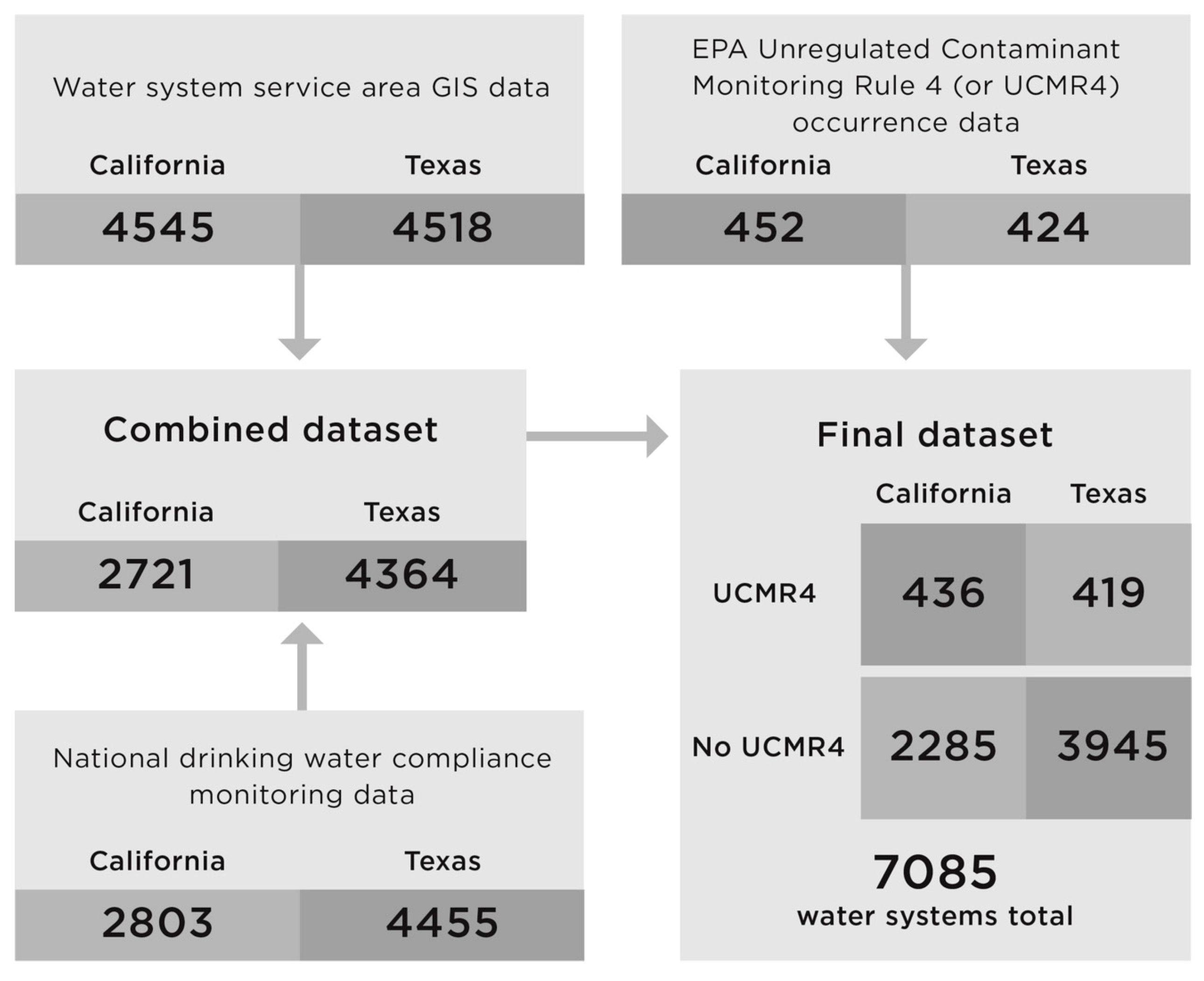
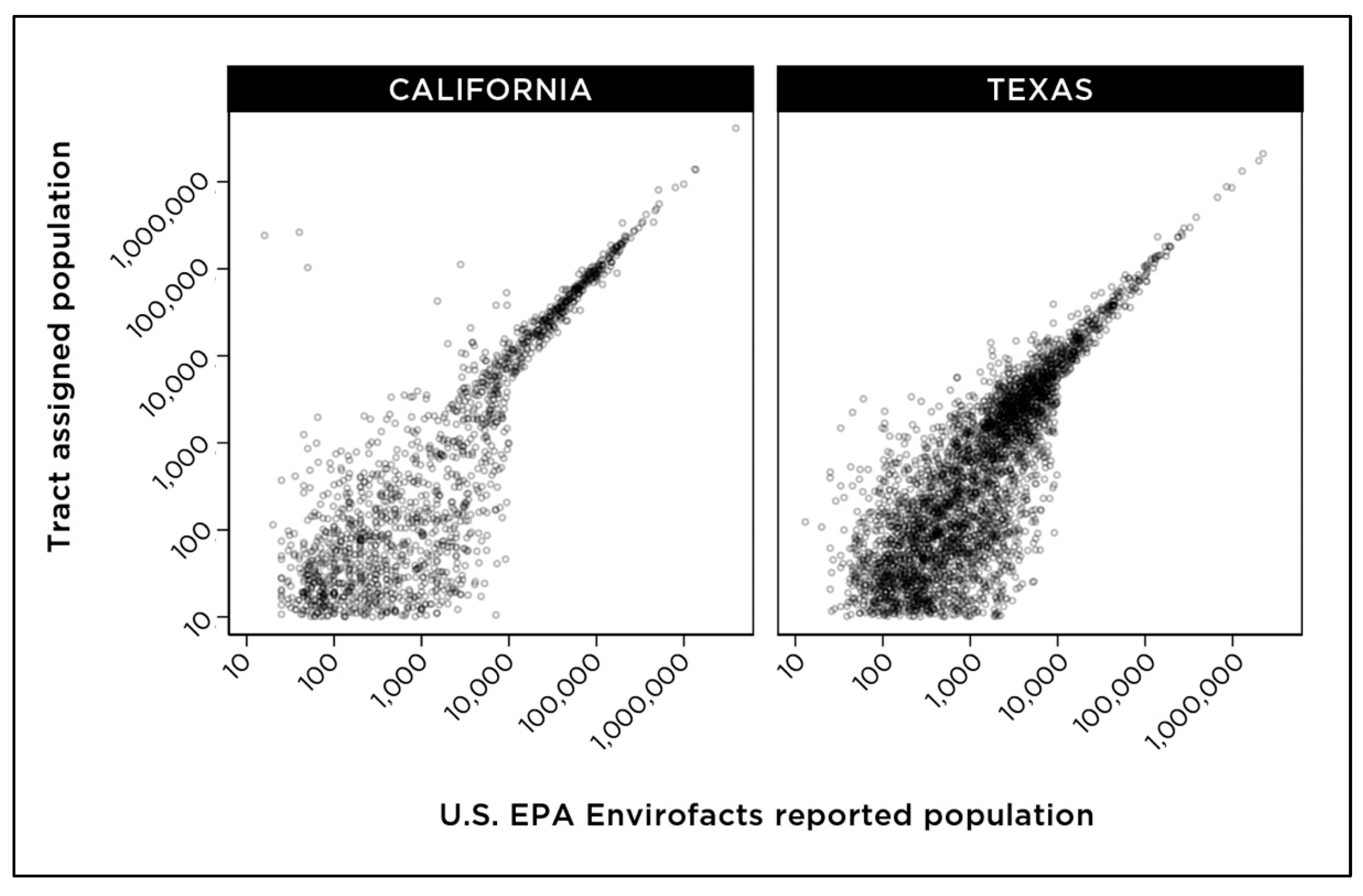
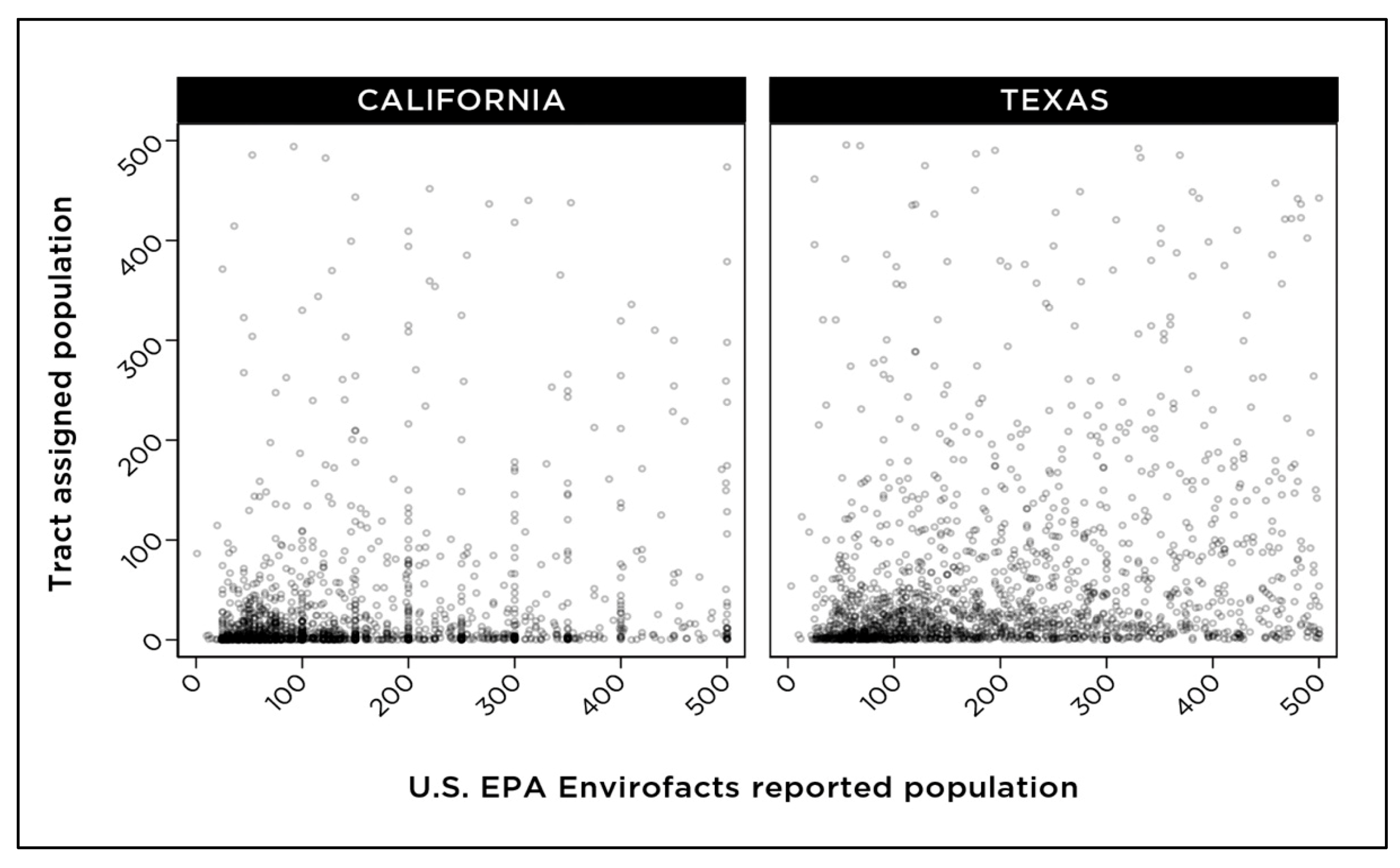
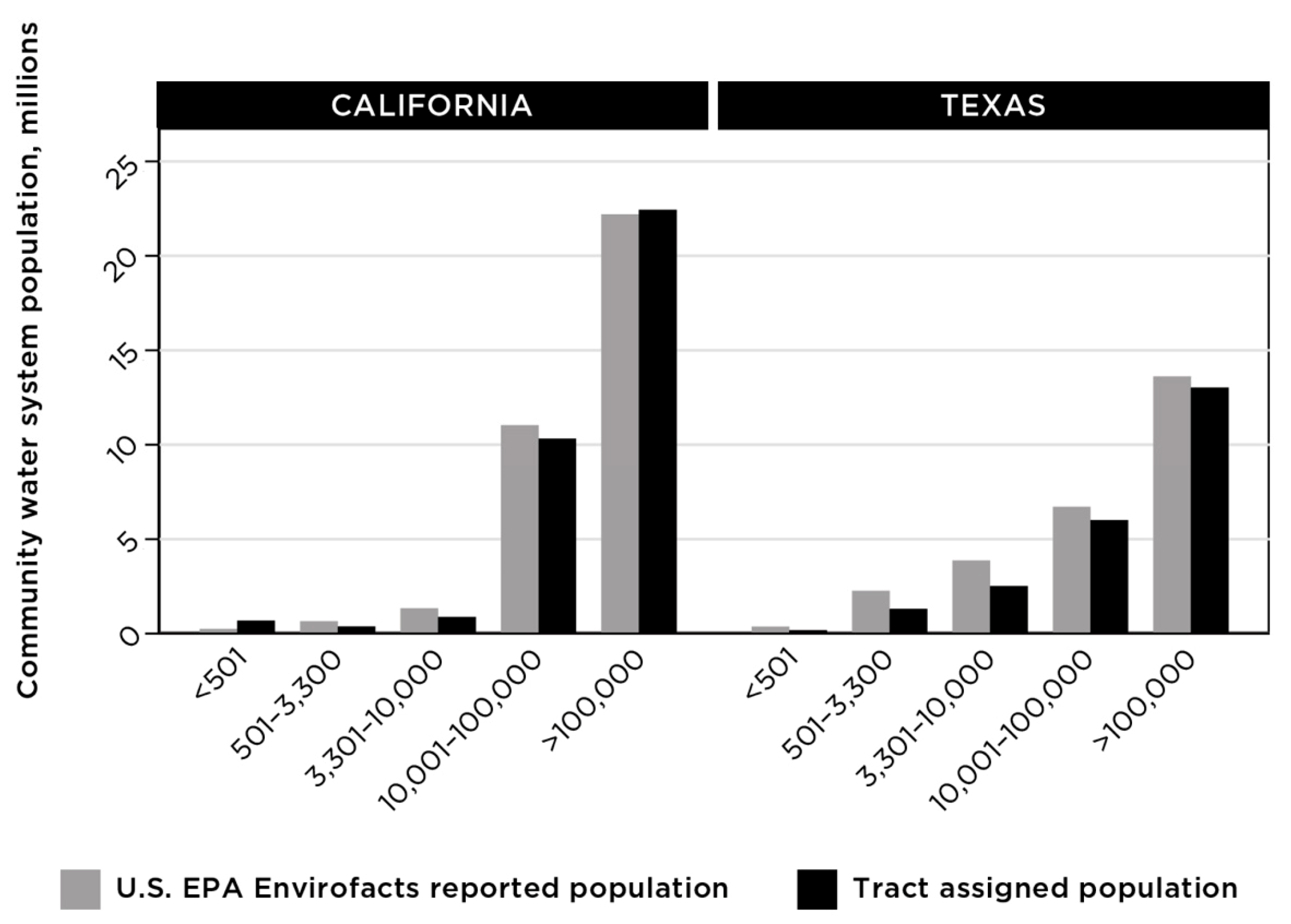
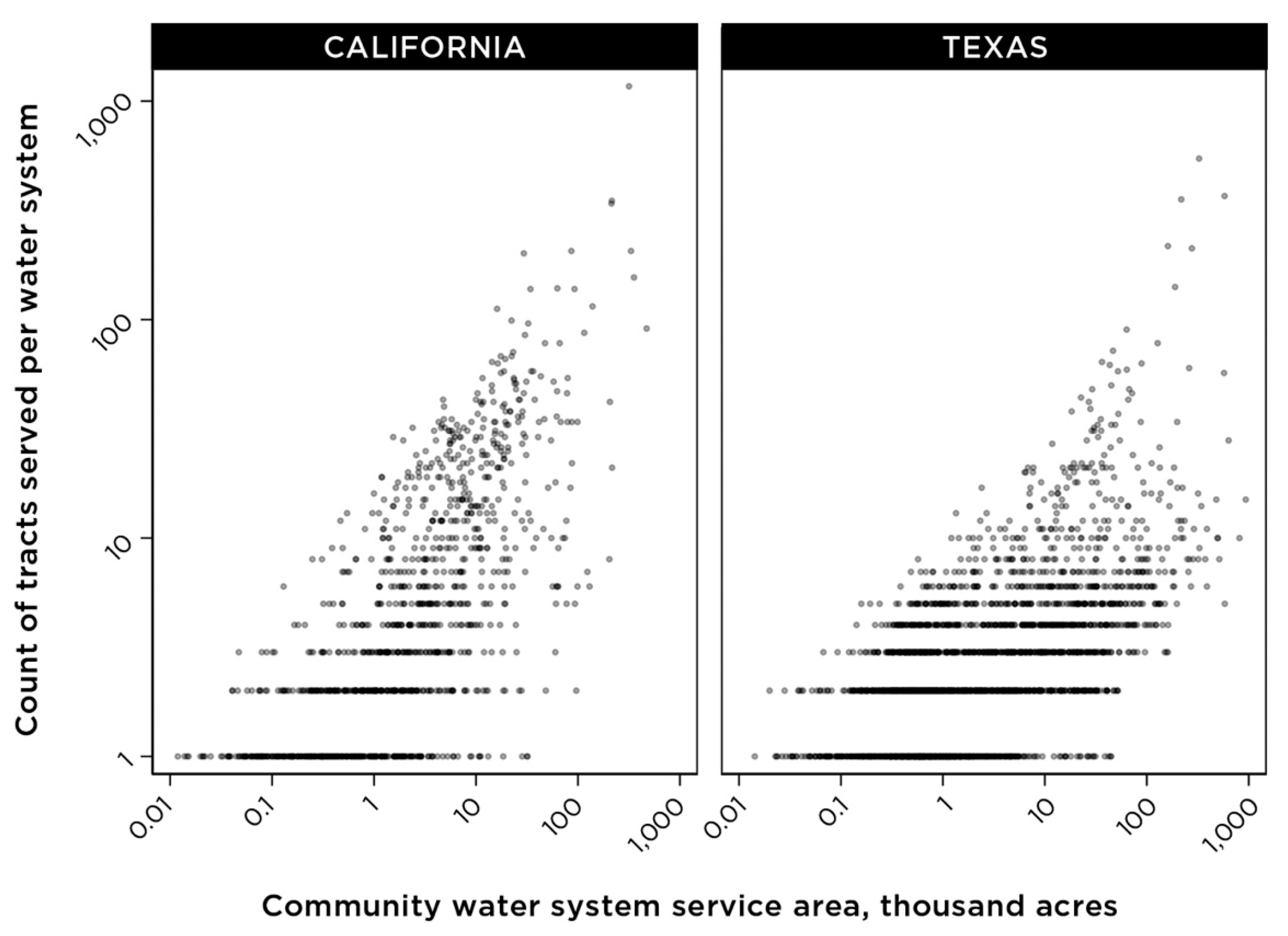
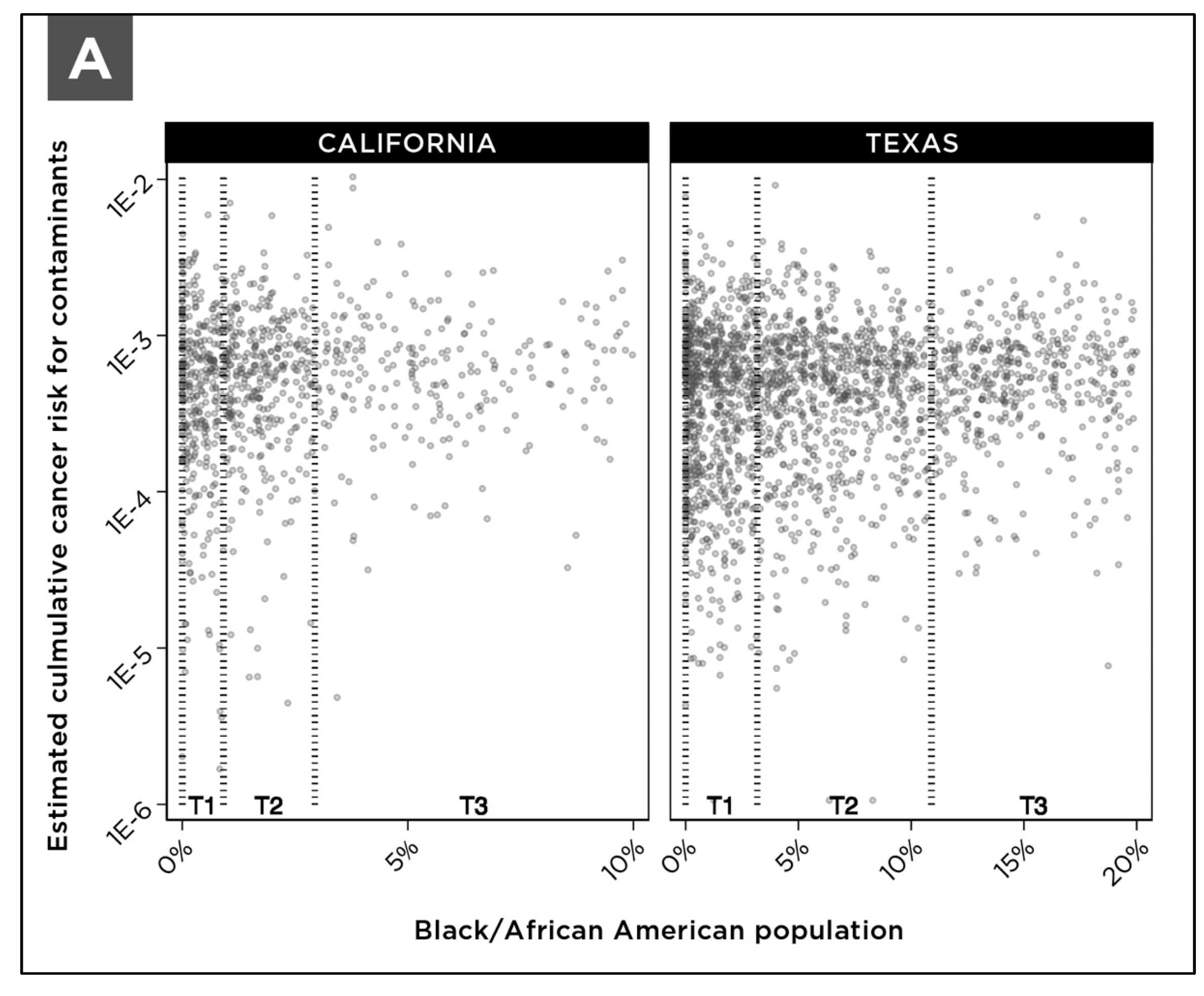
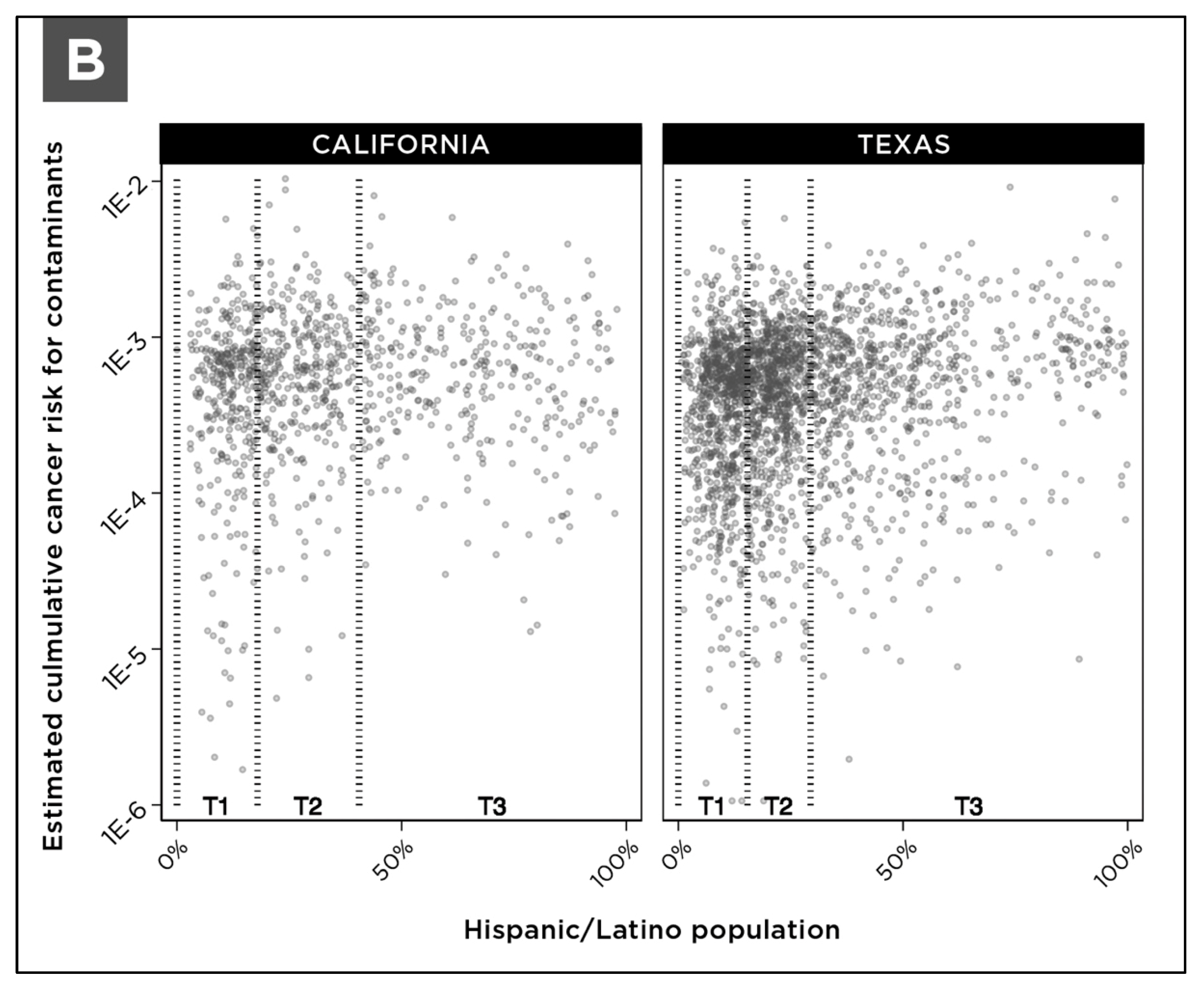
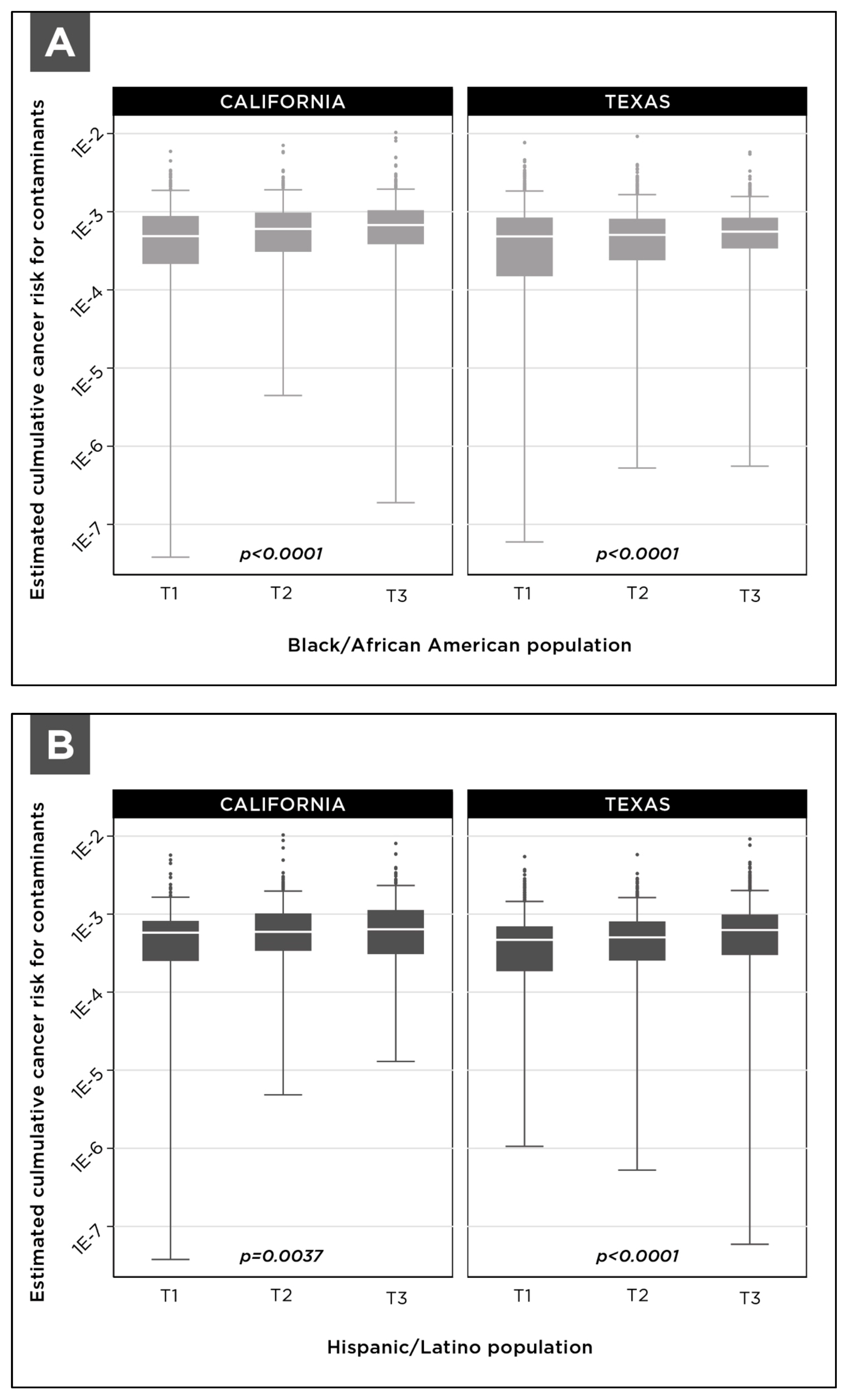
| Contaminant | Number of Systems with Contaminant Detections | Average Contaminant Concentration Across Water Systems of All Sizes | Population Served by Systems with Contaminant Detections, Millions 1 | Population Weighted Average Contaminant Concentration |
|---|---|---|---|---|
| 1,2-dibromo-3-chloropropane | 213 | 0.1 ng/L | 7.1 | 0.3 ng/L |
| 1,2,3-trichloropropane | 400 | 0.2 ng/L | 12.5 | 0.4 ng/L |
| 1,4-dioxane | 1702 | 0.01 μg/L | 89.2 | 0.1 μg/L |
| Arsenic | 16,785 | 0.9 μg/L | 127.1 | 0.6 μg/L |
| Benzene | 190 | 0.9 ng/L | 3.6 | 0.8 ng/L |
| Bromate | 520 | 0.01 μg/L | 29.2 | 0.1 μg/L |
| Carbon tetrachloride | 434 | 1.9 ng/L | 6.0 | 1.6 ng/L |
| Group of 5 haloacetic acid (HAA5) | 31,648 | 8.1 μg/L | 292.8 | 17 μg/L |
| Group of 9 haloacetic acids (HAA9) | 4660 | 20 μg/L | 249.8 | 24 μg/L |
| Hexavalent chromium | 7821 | 0.1 μg/L | 246.9 | 0.4 μg/L |
| Nitrate | 35,555 | 0.9 mg/L 2 | 265.8 | 0.9 mg/L 2 |
| Perchloroethylene | 869 | 0.01 μg/L | 28.8 | 0.02 μg/L |
| Radium-226 & -228 | 22,683 | 0.5 pCi/L | 138.3 | 0.4 pCi/L |
| Strontium-90 | 87 | 0.0005 pCi/L | 2.8 | 0.002 pCi/L |
| Group of 4 trihalomethanes (THM4) 3 | 35,937 | 16 μg/L | 299.4 | 30 μg/L |
| Trichloroethylene | 580 | 0.005 μg/L | 22.7 | 0.02 μg/L |
| Tritium | 84 | 0.3 pCi/L | 1.8 | 1.0 pCi/L |
| Uranium | 8226 | 0.6 pCi/L | 74.4 | 0.5 pCi/L |
| Vinyl chloride | 122 | 0.5 ng/L | 2.1 | 1.8 ng/L |
| Community Water System Size | Demographic Group Defined by the U.S. Census Bureau | Tercile Boundaries for Percentage of Population within a Demographic Group 1 | Total Population in the Tercile, Millions (Rounded) | Median Cumulative Cancer Risk | Jonckheere-Terpstra Trend Test p-Value 2 |
|---|---|---|---|---|---|
| Small (501–3300) | Black or African American | ≤0.5% (T1) | 0.21 | 4.3 × 10−4 | 0.1333 |
| 0.5–2.2% (T2) | 0.21 | 3.5 × 10−4 | |||
| ≥2.2% (T3) | 0.23 | 5.9 × 10−4 | |||
| Hispanic or Latino | ≤14.3% (T1) | 0.21 | 4.4 × 10−4 | 0.0431 * | |
| 14.4–30.6% (T2) | 0.22 | 4.9 × 10−4 | |||
| ≥30.9% (T3) | 0.21 | 4.9 × 10−4 | |||
| Medium (3301–10,000) | Black or African American | ≤0.7% (T1) | 0.43 | 5.9 × 10−4 | 0.6883 |
| 0.7–2.5% (T2) | 0.46 | 5.8 × 10−4 | |||
| ≥2.6% (T3) | 0.45 | 6.6 × 10−4 | |||
| Hispanic or Latino | ≤20.9% (T1) | 0.42 | 5.8 × 10−4 | 0.4065 | |
| 20.9–43.2% (T2) | 0.46 | 6.7 × 10−4 | |||
| ≥43.6% (T3) | 0.45 | 6.0 × 10−4 | |||
| Large (10,001–100,000) | Black or African American | ≤1.5% (T1) | 3.1 | 6.7 × 10−4 | 0.1625 |
| 1.5–3.7% (T2) | 4.2 | 6.7 × 10−4 | |||
| ≥3.8% (T3) | 3.7 | 7.8 × 10−4 | |||
| Hispanic or Latino | ≤23.0% (T1) | 3.6 | 7.2 × 10−4 | 0.1183 | |
| 23.3–44.1% (T2) | 3.8 | 8.0 × 10−4 | |||
| ≥44.5% (T3) | 3.6 | 5.8 × 10−4 | |||
| Very Large (>100,000) | Black or African American | ≤2.6% (T1) | 4.6 | 5.6 × 10−4 | 0.0041 * |
| 2.7–6.4% (T2) | 6.8 | 6.8 × 10−4 | |||
| ≥6.7% (T3) | 10.8 | 7.6 × 10−4 | |||
| Hispanic or Latino | ≤30.0% (T1) | 6.4 | 6.9 × 10−4 | 0.7324 | |
| 30.1–47.7% (T2) | 10.2 | 6.9 × 10−4 | |||
| ≥48.0% (T3) | 5.6 | 6.5 × 10−4 |
| Community Water System Size | Demographic Group Defined by the U.S. Census Bureau | Tercile Boundaries for Percentage of Population within a Demographic Group 1 | Total Population in the Tercile, Millions (Rounded) | Median Cumulative Cancer Risk | Jonckheere-Terpstra Trend Test p-Value 2 |
|---|---|---|---|---|---|
| Small (500–3300) | Black or African American | ≤2.3% (T1) | 0.72 | 4.1 × 10−4 | 0.0005 * |
| 2.3–9.0% (T2) | 0.75 | 4.3 × 10−4 | |||
| ≥9.0% (T3) | 0.79 | 5.0 × 10−4 | |||
| Hispanic or Latino | ≤13.3% (T1) | 0.74 | 4.2 × 10−4 | <0.0001 * | |
| 13.3–25.9% (T2) | 0.76 | 4.2 × 10−4 | |||
| ≥25.9% (T3) | 0.76 | 5.6 × 10−4 | |||
| Medium (3301–10,000) | Black or African American | ≤5.2% (T1) | 1.3 | 5.3 × 10−4 | 0.0598 |
| 5.2–14.5% (T2) | 1.3 | 4.8 × 10−4 | |||
| ≥14.6% (T3) | 1.3 | 5.8 × 10−4 | |||
| Hispanic or Latino | ≤17.5% (T1) | 1.3 | 5.2 × 10−4 | 0.0230 * | |
| 17.5–33.6% (T2) | 1.3 | 5.2 × 10−4 | |||
| ≥33.8% (T3) | 1.4 | 5.5 × 10−4 | |||
| Large (10,001–100,000) | Black or African American | ≤4.2% (T1) | 2.2 | 8.0 × 10−4 | 0.9367 |
| 4.3–12.6% (T2) | 2.2 | 7.0 × 10−4 | |||
| ≥12.6% (T3) | 2.3 | 8.0 × 10−4 | |||
| Hispanic or Latino | ≤21.5% (T1) | 2.2 | 7.6 × 10−4 | 0.1826 | |
| 21.6–37.8% (T2) | 2.1 | 7.3 × 10−4 | |||
| ≥37.8% (T3) | 2.4 | 8.3 × 10−4 | |||
| Very Large (>100,000) | Black or African American | ≤7.9% (T1) | 5.4 | 9.1 × 10−4 | 0.1684 |
| 8.0–13.2% (T2) | 2.1 | 8.2 × 10−4 | |||
| ≥14.3% (T3) | 6.2 | 7.4 × 10−4 | |||
| Hispanic or Latino | ≤26.1% (T1) | 1.7 | 8.2 × 10−4 | 0.1270 | |
| 26.1–42.9% (T2) | 5.0 | 7.9 × 10−4 | |||
| ≥43.0% (T3) | 6.9 | 9.2 × 10−4 |
Publisher’s Note: MDPI stays neutral with regard to jurisdictional claims in published maps and institutional affiliations. |
© 2021 by the authors. Licensee MDPI, Basel, Switzerland. This article is an open access article distributed under the terms and conditions of the Creative Commons Attribution (CC BY) license (https://creativecommons.org/licenses/by/4.0/).
Share and Cite
Uche, U.I.; Evans, S.; Rundquist, S.; Campbell, C.; Naidenko, O.V. Community-Level Analysis of Drinking Water Data Highlights the Importance of Drinking Water Metrics for the State, Federal Environmental Health Justice Priorities in the United States. Int. J. Environ. Res. Public Health 2021, 18, 10401. https://doi.org/10.3390/ijerph181910401
Uche UI, Evans S, Rundquist S, Campbell C, Naidenko OV. Community-Level Analysis of Drinking Water Data Highlights the Importance of Drinking Water Metrics for the State, Federal Environmental Health Justice Priorities in the United States. International Journal of Environmental Research and Public Health. 2021; 18(19):10401. https://doi.org/10.3390/ijerph181910401
Chicago/Turabian StyleUche, Uloma Igara, Sydney Evans, Soren Rundquist, Chris Campbell, and Olga V. Naidenko. 2021. "Community-Level Analysis of Drinking Water Data Highlights the Importance of Drinking Water Metrics for the State, Federal Environmental Health Justice Priorities in the United States" International Journal of Environmental Research and Public Health 18, no. 19: 10401. https://doi.org/10.3390/ijerph181910401
APA StyleUche, U. I., Evans, S., Rundquist, S., Campbell, C., & Naidenko, O. V. (2021). Community-Level Analysis of Drinking Water Data Highlights the Importance of Drinking Water Metrics for the State, Federal Environmental Health Justice Priorities in the United States. International Journal of Environmental Research and Public Health, 18(19), 10401. https://doi.org/10.3390/ijerph181910401






